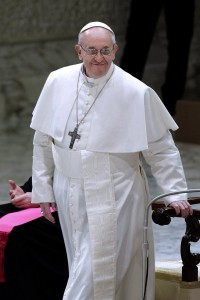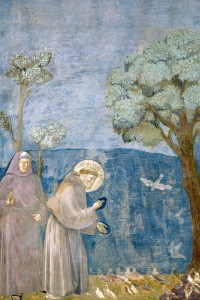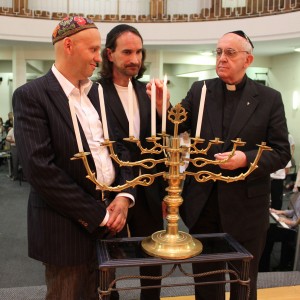Francis’ good connections with the Jews

Pope Francis in Rome
July 18 will always be remembered in Buenos Aires as a day of pain and sorrow. Next year, this date will mark the 20th anniversary of one of the most horrendous anti-Semitic attacks to occur since the Holocaust. It was on this day in 1994 that unknown perpetrators blew up the building housing the Jewish Community Center (Asociación Mutual Israelita Argentinaor AMIA) with a powerful car bomb. This event remains seared on the collective memory of Argentina’s Jewish community, and it is made all the more painful given that those responsible were never brought to justice. In 2005, a petition circulated commemorating the 85 victims of the attack, demanding for the case to be reopened. The first public figure to express his solidarity with the Jewish community and sign the so-called ‘85 Victims/85 Signatures’ petition was none other than Jorge Mario Bergoglio. He was the Archbishop of Buenos Aires and a cardinal at the time. Today, of course, he is the Bishop of Rome and the Pope.
At 8:22 p.m. on March 13, 2013, a man with silver hair and a snow-white cassock appeared on the Vatican balcony and greeted the crowds below with a simple “buona sera.” The world, certainly the Catholic one, was in awe. This man, simply attired and of humble demeanor, would be their new spiritual leader – the Vicar of Christ. The people of Argentina were particularly proud, “He’s a Gaucho, one of us!”
The road to Rome
The man selected in conclave was Jorge Mario Bergoglio, the 76-year-old son of Italian immigrants who had risen through the Catholic hierarchy to become Archbishop of Buenos Aires. During his time in office, Archbishop Bergoglio’s unassuming ways were held in high esteem by the country’s faithful. ‘His Eminence’ did not shy away from taking the bus or riding the subway and he lived in a modest apartment where he cooked his own meals; he was even willing to work in the slums. It was this past which generated so much excitement when the name of the new Pontif was announced – ‘Francis’. Just ‘Francis’. And not ‘Francis I’, as was first reported.
For a Pope to adopt the name ‘Francis’ is a sensation, a revolution. Not one of his 265 predecessors had taken such a daring step. Not only is Jorge Mario Bergoglio the first Latin American and first Jesuit to accede to St. Peter’s throne, but he is also the first ever ‘Francis.’ With this name, he broadcasts his intention to follow in footsteps which could not be greater, or indeed smaller. Smaller, because St. Francis’ humility was legendary, eventually leading to his nickname as il Poverello or the ‘little poor one.’ Born the son of a wealthy Umbrian silk merchant, St. Francis was a dissolute young man at first, fighting in wars and tasting life’s pleasures. Following a conversion experience, St. Francis changed his life, devoting himself entirely to God. He was small too because he made himself ‘small;’ not merely preaching poverty, but living it, forgoing every creature comfort and striving only to spread the Gospel and give glory to God. It was his humility which made him a giant.
The shoes that took these footsteps could indeed prove too large for the new pope to fill. St. Francis is a veritable ‘superstar’ among Catholic saints. The first protector of animals and as such, a medieval forerunner of the modern eco-warrior, the first man acknowledged by the Church to have miraculously exhibited the wounds of Christ (the stigmata); the founder of one of the most successful monastic orders and, if that weren’t enough, he is the patron saint of Italy. Now that’s hard to top.
The legacy that the new Pope is connecting to is a momentous one. It goes beyond basic virtues such as humility and faith. This is particularly true when one considers that St. Francis also personifies the Church’s search for interfaith dialogue. For this symbolism alone, St. Francis has long been held up by members of other religions. Take the Jewish poet Paul Celan, who was so fascinated by Francis of Assisi that he dedicated a poem to him. It begins with the lines:
Umbrian night
Umbrian night with the silver of church bell and olive leaf
Umbrian night with the stone that you brought here
and concludes with:
Brightness that will not comfort, brightness you shed
Still they are begging, Francis — the dead.
As inspired as Paul Celan may have been by the saint, the historical fact remains that, as far as we know, Francis of Assisi had no contact with Jews in his day. But that certainly cannot be said of his namesake in the Vatican. As Archbishop and Cardinal, Jorge Mario Bergoglio has gone out of his way to nurture close ties with the Jewish community.
Rabbi David Rosen, International Director of Interreligious Affairs at the American Jewish Committee, was quoted: “He has had a warm relationship with the Jewish community ofArgentina, and enjoyed close friendships with many prominent rabbis.” World Jewish Congress President Ronald S. Lauder also said: “Pope Francis is no stranger to us. He always had an open ear for our concerns. By choosing such an experienced man, someone who is known for his open-mindedness, the cardinals have sent an important signal to the world. I am sure that Pope Francis will continue to be a man of dialogue, a man who is able to build bridges with other faiths.”
First steps
All this adds up to a sizeable down payment of goodwill. Pope Francis will soon have the opportunity to live up to these high expectations as there are plenty of items waiting on the agenda where Jewish-Christian dialogue is concerned. In fact, the first year of his pontificate will quickly put his commitment to dialogue to the test. This June will see the next meeting of the Permanent Bilateral Working Commission between Israel and the Holy See (the Vatican state being represented by the Holy See, a non-state entity under international law.) The main topic of discussion will be the status of the Catholic Church and its communities/institutions in Israel, particularly with regard to issues of ownership and taxation. In short, questions about money. The meeting is important even if it does not fall under the normal purview of interfaith dialogue between the two closely related Abrahamic religions.
However, the vexed question of the beatification of Pius XII could well overshadow, or even disrupt, this dialogue sooner. Four years ago, theVaticantook steps to beatify Pius XII, a key phase on the path to eventual sainthood. It was a decision that was harshly criticized by Jewish representatives. Despite this, one cannot exclude the possibility that the man born as Eugenio Pacelli could actually be declared a saint in the not too distant future. How Pope Francis will handle the matter remains to be seen.
Walk the line
All eyes will also be on the Pope with regard to his approach to the controversial Society of Pius X, a fundamentalist splinter group founded by the excommunicated Archbishop Marcel Lefebvre. This was the group notorious for tolerating a Holocaust-denying bishop in its ranks until recently, a group whose leaders still inveigh against the Jews as “murderers of God.” Pope Francis’ predecessor Benedict XVI, though himself free of any hint of anti-Semitism, made significant concessions to the Society of Pius X out of his desire to restore harmony within the Church. Pope Francis, for his part, will have to take care not to let this love of unity turn into a tolerance of hatred against diversity or other communities. This means that the Pope will have to scrupulously stick to the Church’s official line, namely the one spelled out in Nostra Aetate, the official Declaration of the Second Vatican Council. In all probability, he will do just that.
Signal of importance
By expressing solidarity with the victims of July 18, 1994 – and in other ways as well – Cardinal Bergoglio has built up a considerable reservoir of goodwill with the Jewish community. This is a relationship of trust that he will have to continue to nurture as Pope Francis. And that will not always be easy, however, given that the responsibilities of the head of the Catholic Church are quite different from those of an Archbishop. That he will have to learn to accept criticism from the Jewish community we can take for granted.
Ultimately, his challenge will be to continue to deepen Christian-Jewish dialogue, making it even more constructive in the process. Among the myriad tasks and hurdles facing the shepherd of a flock of over a billion human beings, steering the Church’s relationship with the Jewish people is surely one of signal importance. The fact that many observers already see the relationship as being warm and friendly merely sets Pope Francis a much higher benchmark. How high? Quite high indeed, if we are to believe Shimon Peres’ words back in 2010, “Relations are at their best possible from 2000 years to this day. From the time of Jesus to today we have never had better relations.”
Simon Biallowons is a reporter, he was Vatican-correspondent from 2010 to 2012. He is the author of the recently published book “Franziskus, der neue Papst”, Kösel


